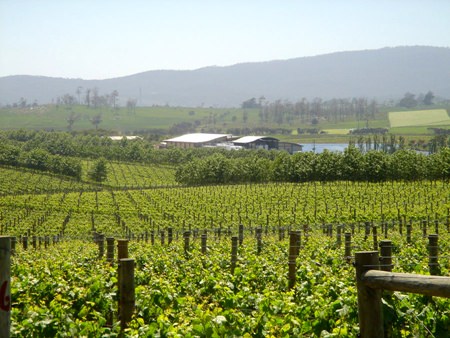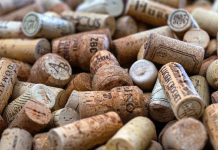Well then, here’s something interesting. I’m sure you’ve noticed the increasing number of fruit wines appearing in the supermarkets during recent months. What you may not have realised is that most of them are produced by the same company here in Thailand. I’ve tasted nearly all these wines in the line of duty, and many of them are perfectly respectable everyday drinkers. My only reservation is that some of the wines lack depth and interest.
These relatively new arrivals from Australia are available in standard bottles and five-litre boxes. They also come in heavy two-litre glass flagons which are fine I suppose if you can finish the whole lot in one evening. You can’t have missed them, because Castle Creek are currently on sale in several different outlets. You can’t have missed the price either for these wines must be some of the cheapest in town. The bottles sell at a mere Bt. 269 and the five-litre boxes are only Bt. 859, the equivalent of only Bt. 130 per bottle. However, these prices apply only until 15th January 2015, when the bottles revert to the normal price of Bt. 299 and the boxes revert to Bt. 969. “Ah yes,” I hear you say, “But are they any good?” Well yes, actually. They’re very good indeed.
 Castle Creek vineyards
Castle Creek vineyards
Not long ago, wine drinkers were sometimes a bit sniffy about boxed wines, which was not altogether surprising because they had a rather dodgy reputation. For a lot of ex-pats and especially the nouveaux pauvres, boxed wines are now a preferred option purely on the grounds of price. Australians like to call them “wine casks” but they’re the same thing: a sealed plastic bag of wine inside a cardboard box. As the wine is poured, the bag deflates inside the box, ensuring that the air doesn’t make contact with the wine. So unlike a bottle, the wine stays fresh for a few weeks after opening, because it’s not subject to oxidation. There’s no risk of cork taint either and because packaging, shipping and storage are less expensive, wine boxes are better value than bottles. They’re also easy to open, in theory at least.
Castle Creek Crisp Dry White, (Australia) (75cl bottle Bt. 269; 5-litre box Bt. 859 @ Big C Extra and others*)
This is a very pale straw-coloured, bright-looking wine. There’s an aroma of peppery citrus with tropical fruit in the background. On the palate, there’s a pleasant dash of refreshing citrus too and a crisp zing of acidity. The wine is very light in body and produced from a blend of Sauvignon Blanc and Sémillon grapes.
We don’t hear very much about Sémillon, despite the fact that it’s one of the traditional white grape varieties of Bordeaux. It’s also popular among Australian wine-makers especially for blending, and it brings aromas of lemon, gooseberry, tropical fruit and even a hint of freshly-cut grass. That’s a smell I’ll never forget because when I was a teenager, encounters with freshly cut grass brought on devastating attacks of hay fever. Strangely enough, as I’ve become older that allergy has faded away and I find that these days I am allergic only to the smell of tigers. There’s not a trace of tiger aroma on this wine, although as you may know, Sauvignon Blanc can sometimes carry the distinctive odour of cat’s pee. There’s not a trace of that either, you’ll be pleased to know. Or perhaps you won’t. You might even be profoundly disappointed. I have heard that some peculiar people live in these parts. (Oh, do get on with it – Ed.)
Now then, where was I? Oh yes, the wine isn’t totally dry but just a few degrees away and there’s a decently long and satisfying finish. Quite honestly, I’d never guess that this is a fruit wine. It’s a very well-crafted product and a good deal more interesting than some of its competitors.
Castle Creek Crisp Dry Red, (Australia) (75cl bottle Bt. 269; 5-litre box Bt. 859 @ Big C Extra and others*)
This dark red wine is a blend that includes both Shiraz and Cabernet Sauvignon and if you swirl it around in the glass, you’ll see those little rivulets known as “legs” appearing on the inside surface. These are usually an indication of a wine high in alcohol and this one comes at 13% ABV which is not at the top of the tree, but high nonetheless. If you’ve got a good nose you might detect it as a kind of heat sensation on the aroma. There’s lovely dark fruit there too and further sniffing reveals smells of red currants, blackberries and hints of brambles and herbs. There’s also a faint peppery sensation that presumably comes from the Shiraz in the blend. The mouth-feel is soft and seductive with just the slightest tang of acidity that firms up the body. The wine is dry of course, quite light-bodied and plenty of light red fruit on the palate. Red currants, I’d guess.
There’s a dry lingering finish that carries the fruit along with it. Despite the rock-bottom price this is a well made wine. It has an interesting taste too and I think it would make an excellent partner for many light dishes. The pleasing dash of acidity would also make it ideal for pizza and pasta. Although it’s light and undemanding there’s a depth to the aroma and taste which you rarely find in fruit wines. Just out of interest I compared it with a very well-known fruit wine made here in Thailand. The local wine tasted one-dimensional in comparison.
Even if you are one of those people who claim to prefer their reds at “room temperature” (which is too vague an expression to be of much practical value) I’d suggest that you drink this wine on the cool side, because the cooler temperature will make the wine feel firmer. Served warm, the wine will seem flabby and unbalanced, a bit like some of the old blokes down at the local bar.
* Don’t forget these prices apply only until 15th January 2015.




